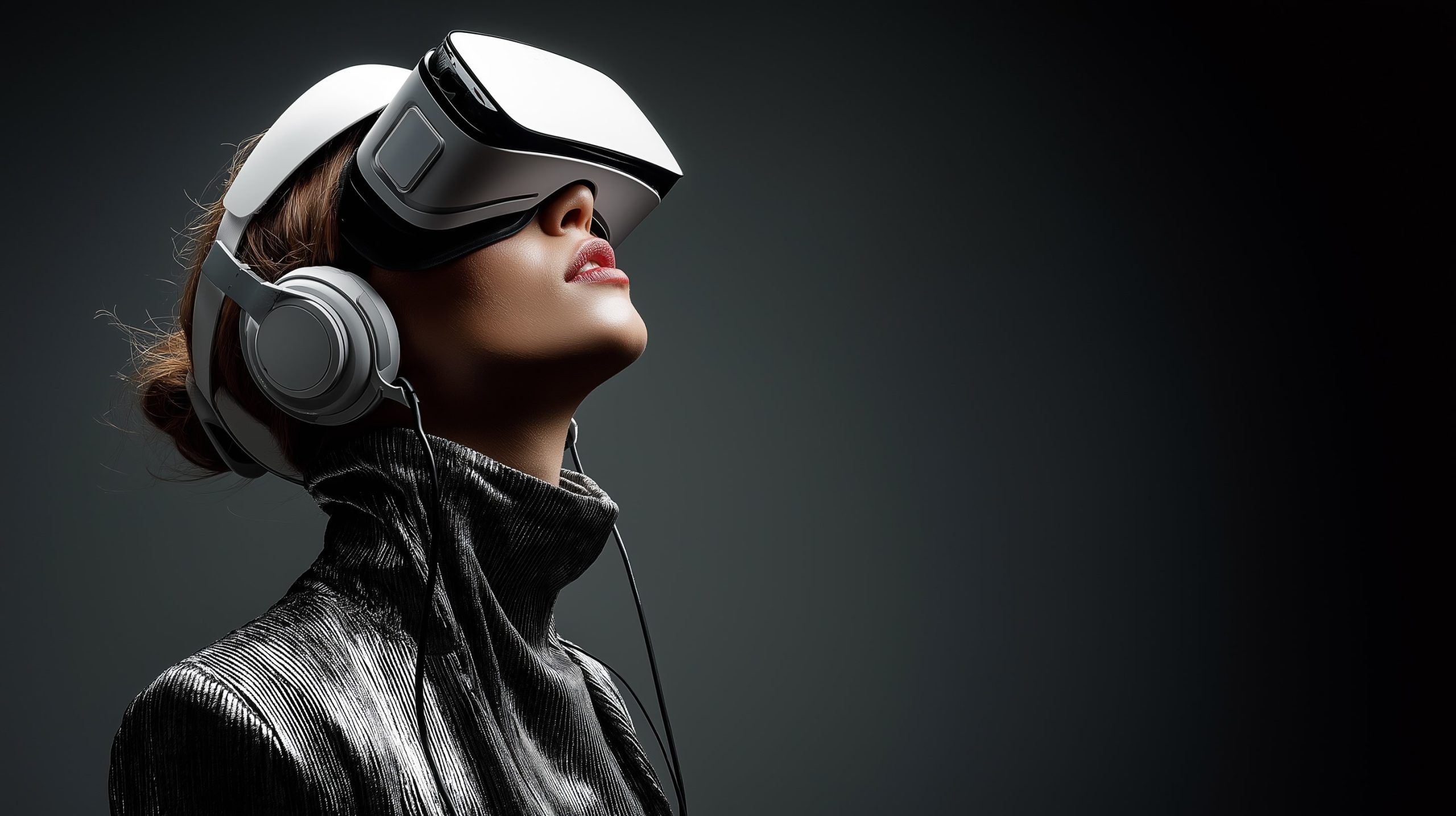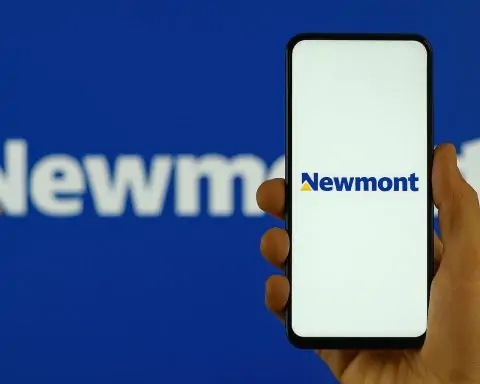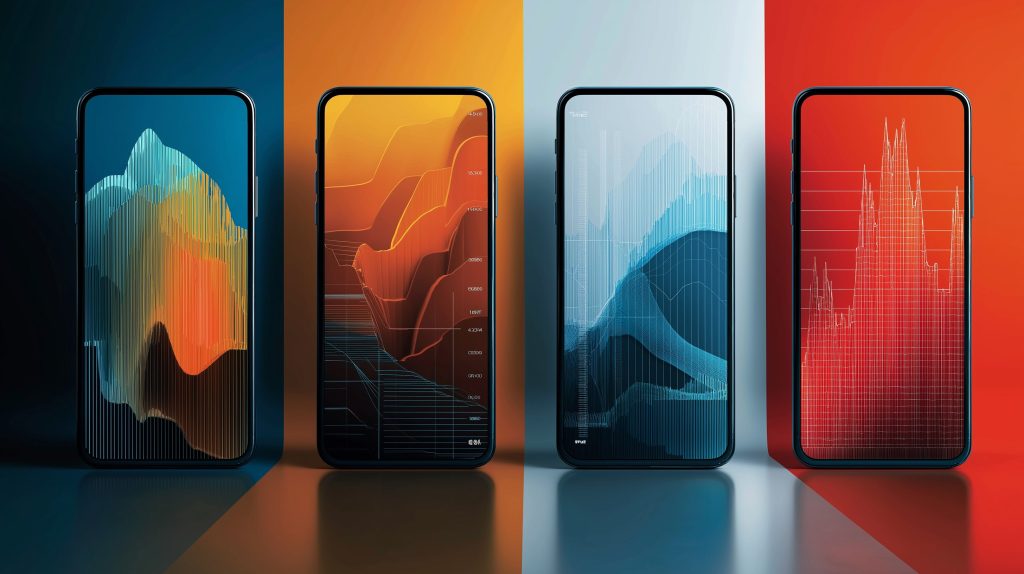- Meta’s Quest 3, released in late 2023, is a standalone VR headset with mixed reality capabilities that is roughly twice as powerful as its predecessor and features high-resolution pancake lenses plus full-color passthrough for MR.
- Apple’s Vision Pro, announced in mid-2023 and released in early 2024, costs about $3,500 and uses dual 4K micro-OLED displays with advanced eye- and hand-tracking and passthrough AR for spatial computing.
- Samsung and Google’s Project Moohan XR headset is slated for late 2025, uses Qualcomm Snapdragon XR2+ Gen 2, reportedly delivers up to 4.3K per-eye displays with pancake optics and color passthrough, and runs an Android XR platform.
- Meta is licensing Horizon OS to Asus and Lenovo to produce specialized VR headsets, including Asus’ ROG gaming-focused unit with eye and face tracking and Lenovo’s productivity-oriented MR device.
- Sony’s PlayStation VR2 (launched 2023) accounted for roughly 6–9% of 2024 headset shipments, with over 2 million units produced by Q1 2024, and production paused to clear unsold inventory as there’s no PSVR3 on the near horizon.
- Valve’s SteamVR remains the central PC VR platform, compatible with essentially all PC headsets and OpenXR, hosting the largest library of hardcore simulator and modded VR content, while rumors point to an Index 2 (codenamed Deckard) and new controllers (codenamed Roy).
- By 2024, the global VR market was valued around $38–40 billion with about 171 million people using VR, and shipments are expected to reach $67–70 billion in 2025, with 2024 US users at about 77 million and projections of 80+ million in 2025.
- Enterprise engagement is strong, with about 91% of businesses using or planning VR/AR, roughly 51% already integrating VR in at least one business line, and 34% citing training as a top benefit.
- The 2025 hardware trend prioritizes premium, lighter, MR-capable headsets and a slower cadence of all-new budget devices, with mass-market support from incremental updates like Meta’s Quest 3S (starting at $299) and no Quest 4 planned for 2025.
- AI is increasingly integrated into VR, featuring AI NPCs and tutors, on-demand AI-generated content, and tools to aid scene creation, as analysts expect AI to boost immersion and reduce content-creation barriers by 2025.
Virtual Reality (VR) has entered 2025 with significant momentum and some pivotal new entrants. After years of being driven largely by gaming and experimental uses, VR is now maturing into a broader platform spanning consumer entertainment, enterprise training, and social connectivity. The first half of 2025 saw major hardware launches and announcements – most notably Apple’s foray into “spatial computing” – alongside steady growth in VR content libraries. At the same time, market data and analyst forecasts indicate that while VR adoption continues to expand, the industry is recalibrating expectations and shifting toward mixed reality (MR) experiences and practical use-cases. Below, we break down the latest developments in VR hardware, software, platforms, market trends, investments, and expert forecasts as of mid-2025, and highlight what’s on the horizon for the rest of the year.
VR Hardware Advances and New Headsets in 2025
Meta’s Quest 3 headset (pictured with its controllers) exemplifies the 2025 trend toward standalone VR devices with mixed reality capabilities, offering full VR immersion as well as color passthrough for augmented reality experiences.Hardware innovation remains at the heart of VR’s evolution in 2025. The industry’s emphasis has shifted toward standalone headsets that are more powerful, comfortable, and versatile than earlier generations. Meta’s Quest 3, released in late 2023, set the benchmark for this generation – it’s roughly twice as powerful as its predecessor and notably slimmer, yet still offered at a consumer-friendly price point [1] [2]. The Quest 3 introduced high-resolution pancake lenses, improved motion tracking, and full-color passthrough cameras for mixed reality, making MR a standard expectation for new VR devices [3] [4]. In fact, any VR headset launching without mixed reality functionality now faces a competitive disadvantage, as it limits the device’s utility compared to MR-enabled rivals [5] [6]. Meta has already capitalized on this trend by releasing a cheaper variant, the Quest 3S, in October 2024 at a $299 starting price, to make MR more accessible [7] [8]. This strategy reflects an industry-wide push toward mass-market VR, where lowering cost and friction is key to driving adoption.
Apple’s $3,500 Vision Pro headset (shown here during a demonstration) has brought premium design and cutting-edge technology into the VR/AR arena, sparking both excitement and debates about mainstream appeal. The most high-profile hardware debut was undoubtedly Apple’s Vision Pro, Apple’s first VR/AR device (branded a “spatial computer”). Announced in mid-2023 and released in early 2024, the Vision Pro is a premium mixed reality headset priced at roughly $3,500, featuring dual 4K micro-OLED displays, advanced eye- and hand-tracking, and a novel passthrough AR interface [9] [10]. Apple’s entry instantly set new standards for technical performance and design – the Vision Pro’s ultra-sharp visuals (23 million pixels across its displays) and intuitive gesture-based controls delivered an “unmatched visual experience” according to early reviews [11] [12]. This headset blurs the line between VR and AR, enabling users to seamlessly blend virtual content with their real environment, and Apple touted it as a device that can “work, play, and live differently” through spatial computing [13] [14]. The impact of the Vision Pro has been twofold: it raised the bar technologically – competitors like Meta, HTC, and others are now under pressure to match its display quality and interface innovations – but it also underscored the challenges of ultra-premium VR. Initial reports indicate that the Vision Pro saw limited early sales and lukewarm adoption beyond Apple enthusiasts, due in part to its very high cost and the question of everyday use cases for such a device [15] [16]. In fact, by late 2024 there were rumors (later downplayed) that Apple might scale back production after slower-than-expected traction [17] [18]. Apple appears to be adjusting its roadmap accordingly – rather than fast-tracking a full Vision Pro 2, insiders say Apple is focusing on developing a more affordable VR/MR headset for release by late 2025 or 2026 [19] [20]. A modest revision of the current Vision Pro hardware (possibly upgrading it with a new Apple silicon chip) could arrive in late 2025, but a truly next-gen Apple headset isn’t expected until further out [21] [22]. This suggests that even as Apple’s debut validated VR/MR in the eyes of many, the company is conscious of the need to bring costs down and clarify the device’s value for mainstream users.
Meanwhile, other major players are contributing to a dynamic VR hardware landscape in 2025. Sony’s PlayStation VR2 (launched in early 2023) remains the flagship tethered VR system for console gaming, with PS5-powered high-fidelity visuals and titles like Gran Turismo 7 VR and Resident Evil Village VR catering to hardcore gamers. However, PSVR2’s market impact has been mixed – it accounted for roughly 6–9% of 2024 headset shipments (second behind Meta) [23] [24], but sales have lagged behind Sony’s initial expectations. By Q1 2024, Sony had reportedly produced over 2 million units yet paused production to clear unsold inventory, reflecting a slower uptake than anticipated [25] [26]. This suggests Sony’s VR strategy may be reevaluated; there are no signs of a PSVR3 on the immediate horizon, and Sony’s focus in late 2025 seems to be on driving game content and perhaps improving PC compatibility for PSVR2 to broaden its appeal [27]. In the PC VR arena, enthusiasts still have options like the Valve Index and HTC Vive line, but here too the trend is toward next-generation devices. Valve has long been rumored to be developing a successor to the 2019 Index (code-named “Deckard”). While Valve hasn’t officially announced it, late-2024 datamines uncovered references to new VR controllers (code-named “Roy”) in SteamVR’s code, hinting that Valve’s Index 2 might be forthcoming [28] [29]. This hypothetical device could blend PC VR and standalone capabilities – essentially a “Steam Deck for your face” – allowing wireless PC game streaming or onboard Android-based VR gaming [30] [31]. HTC, on the other hand, pivoted in 2023 toward enterprise and lightweight VR. They introduced the Vive XR Elite and later a Vive Focus Vision headset, emphasizing compact form factors. Rumors of an HTC ultra-premium standalone (using Qualcomm’s latest XR2+ Gen2 chipset) swirled, but the project’s status is uncertain, especially after parts of HTC’s VR team were reportedly acquired by Google to help with its AR glasses efforts [32]. As of 2025, HTC’s contribution is expected to center on enterprise solutions and possibly one more self-contained high-end headset, if development hasn’t been shelved [33] [34].
Notably, 2025 has fewer big headset launches than the previous couple of years – but one major debut is highly anticipated: Samsung and Google’s joint XR headset, known internally as “Project Moohan.” This device is set to arrive in late 2025 and marks Google’s re-entry into the XR fray with a new Android-based VR/AR operating system (sometimes called Android XR) [35] [36]. Project Moohan is expected to be a cutting-edge mixed reality headset featuring Qualcomm’s latest Snapdragon XR2+ Gen 2 chip (outperforming the Quest 3’s processor by ~15-20%), high-resolution displays up to 4.3K per eye, pancake optics, and color passthrough with eye-tracking for foveated rendering [37] [38]. Samsung is reportedly adopting a design similar to Apple’s (including a lightweight build with an external battery pack to reduce head-mounted weight) [39] [40]. The Samsung/Google headset will run a new Android XR platform, meaning it can leverage the Android app ecosystem (including native Google apps like Maps, YouTube, etc.) and integrate Google’s AI assistant for unique features [41] [42]. In essence, this launch adds a third major ecosystem to the VR landscape (alongside Meta’s and Apple’s), potentially kicking off a three-way platform battle that will shape the industry for years [43]. Other hardware developments in 2025 include VR device partnerships: Meta announced it is licensing its Horizon OS (the Quest operating system) to external manufacturers, with Asus and Lenovo developing specialized VR headsets on Meta’s platform [44] [45]. Asus is reportedly building a gaming-focused headset (under its ROG brand) with features like eye and face tracking, while Lenovo is working on a productivity-oriented mixed reality device [46] [47]. These partner devices could arrive in 2025, giving Meta a way to counter Samsung/Google’s entry with a wider hardware lineup [48]. We’re also seeing a wave of innovative niche headsets from startups: for example, the Pimax Portal and Pimax Crystal (high-resolution PC VR hybrids) started shipping, Bigscreen’s Beyond (an ultra-lightweight PC VR headset) reached early backers, and projects like the Immersed Visor (a micro-OLED productivity headset) and Shiftall’s MeganeX 8K glasses are trying to push the envelope on form-factor and visual fidelity [49] [50]. Many of these are limited-run or crowdfunded devices targeting enthusiasts and professionals. The broader trend in 2025 hardware, however, is clear: premium, lighter, and mixed reality-capable headsets are the focus, albeit often at prices that put them out of reach for casual consumers [51]. Indeed, industry observers note that 2025’s VR hardware releases skew toward expensive “pro” devices and experimental ultra-light glasses, which, while exciting technologically, remain niche due to cost [52]. The mass-market is expected to be served more by incremental updates (like Meta’s Quest 3S) and content bundles rather than all-new budget hardware this year. Meta is not expected to launch a Quest 4 in 2025, for example – its roadmap points to the next major Quest in 2026 or beyond [53]. In summary, VR hardware in 2025 is marked by consolidation and polish: the devices on the market are the best yet in terms of immersion and capability, but the industry is pausing the rapid release cadence of past years to refine use-cases and build the content ecosystem for these powerful new headsets.
VR Software and Content: Games, Apps and Experiences
If hardware is reaching new heights, software and content are the engines that must catch up to fully realize VR’s potential. In 2025, VR’s content library has grown more diverse than ever, expanding well beyond its gaming roots. VR gaming remains a cornerstone, with several high-profile titles launching recently or on the way. For example, Meta’s in-house studios released Asgard’s Wrath 2 (a sprawling action RPG) on the Quest platform in late 2023, demonstrating that standalone headsets can handle large-scale “AAA” content. Ubisoft’s Assassin’s Creed Nexus VR also debuted on Quest, bringing a popular game franchise into VR with a full-length adventure. For PlayStation VR2, titles like Horizon: Call of the Mountain (an exclusive launched with the headset) and the VR mode of Gran Turismo 7 have been showcases for high-end VR graphics. Heading into late 2025, gamers can look forward to a lineup of new VR games across genres – from racing simulators (Assetto Corsa EVO is slated to introduce realistic driving in VR) to shooters and horror experiences. Independent developers continue to contribute innovative games as well, often experimenting with VR’s unique interaction models. Monthly release roundups show a steady stream of Quest, PC VR, and PSVR2 gameslaunching throughout 2025 [54] [55], indicating that content momentum is strong, even if no single title has yet become a system-selling blockbuster on the level of flat-screen games.
One trend in VR content is the rise of social and collaborative platforms. Apps like VRChat, Rec Room, and Meta’s own Horizon Worlds are evolving as virtual hangouts, creative spaces, and gaming hubs for millions of users. In 2025, social VR is beginning to redefine how people interact online – users can attend virtual concerts together, celebrate birthdays in VR, or just explore user-generated worlds with friends. Many young people now treat these immersive platforms as an alternative social media outlet [56] [57]. Meta’s Horizon Worlds, for instance, has been updated to be accessible not just on headsets but also via the web and mobile, aiming to grow its user base. While the initial “metaverse” hype (the grand vision of a unified virtual world) has cooled down – with the buzzword used less in marketing – the practical elements of the metaverse are taking shape in these focused social experiences. 2025’s approach is less about a single virtual universe and more about specific, useful virtual spaces: coworking environments, community meet-ups, virtual classrooms, and branded entertainment events [58]. Notably, one of 2023’s biggest moves in social VR was the arrival of Roblox (a massively popular user-generated game platform) on VR headsets. Roblox launched on Meta’s Quest in late 2023, instantly bringing its huge library of kid-friendly games and millions of creators into VR [59] [60]. This has boosted engagement, particularly among Gen Z users, and is a sign of traditional gaming platforms extending into VR to reach new audiences. We also see continued popularity of multiplayer VR games (like Echo VR or Population: One in previous years) which emphasize that presence and interaction are VR’s killer features that regular games can’t replicate.
Beyond entertainment, enterprise and educational VR applications have expanded significantly. Virtual reality in the workplace is no longer experimental; it’s becoming a standard tool for certain use cases. By 2025, 91% of businesses report that they are either using or planning to adopt VR/AR technologies in some form [61] [62]. One of the most common applications is employee training and simulation. Companies are using VR training modules to onboard employees, practice safety procedures, or simulate customer interactions in a risk-free virtual environment. This trend gained momentum in recent years – for example, major retailers and manufacturers have deployed VR training to thousands of employees, citing cost savings and higher retention of knowledge. According to industry surveys, 34% of companies specifically see training and skill development as a top benefit of VR/“metaverse” tech [63] [64]. In fields like medical education, VR surgical simulators and anatomy visualization tools are helping students practice procedures without needing a physical cadaver or live patient. Virtual classrooms and field trips are another growing segment – students can don headsets to explore historical sites, the solar system, or inside a human cell, making learning immersive and engaging in ways textbooks cannot. Studies have noted that such experiential learning in VR can improve memory and understanding compared to traditional methods [65] [66]. Some educational VR content is reaching mainstream app stores, from language-learning apps that put you in conversation scenarios, to science labs in VR.
Another area of rapid growth is VR for healthcare and wellness. In clinical settings, therapeutic VR is being used to treat anxiety disorders, phobias, and PTSD by safely exposing patients to triggers in a controlled virtual environment [67]. VR meditation and stress relief apps transport users to calming natural environments for mindfulness sessions. Notably, VR has shown effectiveness in pain management: hospitals have employed VR experiences to help patients, including children, reduce pain and anxiety during procedures or rehab. This year, VR programs for mental health – sometimes in combination with biometrics or AI coaches – are gaining more evidence and acceptance, complementing traditional therapy. In the fitness domain, VR workouts have carved out a loyal user base. Apps like Supernatural, FitXR, and Beat Saber turn exercise into a game or guided experience, allowing people to box, dance, or sword-slice to music in scenic virtual locales [68] [69]. The “VR fitness” trend has proven that immersive workouts can keep people engaged in ways home gym equipment often fails to. Meta’s acquisition of Within (makers of Supernatural) in 2023 underscores how important fitness use-cases are to the VR strategy [70] [71]. Indeed, fitness and rhythm games consistently rank among the most-downloaded titles on the Quest store. By 2025, VR exercise subscriptions and accessories (like VR weighted vests or dedicated stationary bikes for VR cycling) form a small but growing niche in the broader fitness industry.
Finally, we’re seeing AI integration in VR experiences. With the surge of generative AI, VR developers are starting to incorporate AI-driven elements to make virtual environments more dynamic and intelligent. For instance, some VR games now feature AI NPCs (non-player characters) that can carry unscripted conversations, making encounters feel more realistic. Educational apps use AI tutors that adapt their teaching pace and style to the user [72]. Creation tools in VR – for building worlds or 3D models – are leveraging AI to assist users (imagine simply describing a scene and having the AI generate a rough virtual environment automatically). In social VR, AI-powered avatar animations or content moderation bots are being tested. 2024 saw XR and AI “converge” in many analysts’ eyes [73] [74], and in 2025 this trend is accelerating. The goal of AI in VR is to enhance immersion through more believable interactions and to lower the barrier to content creation. While it’s still early, industry predictions hold that AI will play a key role in the next generation of VR content, making experiences more adaptive and personalized [75] [76].
Platform and Ecosystem Updates (Meta, Apple, Google, and Others)
The VR landscape in 2025 is increasingly defined by a few major ecosystems and their competing visions. Meta(formerly Facebook) continues to lead the market in user base and hardware sales, and it has been doubling down on building a comprehensive VR platform. By the end of 2024, Meta accounted for roughly 70–75% of all AR/VR headset shipments worldwide [77] [78] – a dominance driven by the popularity of the Quest lineup. This gives Meta a huge install base to attract developers and content creators. In response, Meta has been expanding its Quest Store library (over $2 billion has been spent on Quest apps to date, indicating a growing content economy [79]) and improving support for developers. At the 2024 Meta Connect conference, the company launched a new “Meta for Developers” hub and announced a more open Horizon OS with tools for easier content distribution [80] [81]. The strategy is to nurture a “vast ecosystem” of third-party VR apps, moving beyond first-party titles. Meta also made a significant move in April 2024 by allowing select partners (like Asus and Lenovo) to use its VR operating system on their own devices [82]. This effectively positions Meta’s Horizon platform akin to Google’s Android model – seeking wider adoption of its software even on hardware it doesn’t manufacture, which could amplify the reach of Meta’s app ecosystem.
On the social and metaverse front, Meta’s performance has been mixed. Its flagship virtual world, Horizon Worlds, has not yet become the mass social hub Meta envisioned (early traction was limited to a few hundred thousand users). But Meta hasn’t given up – in 2025 they have been improving avatars (adding legs and more realism), opening Horizon Worlds to mobile and PC users (not just VR), and integrating it with popular franchises to attract users (e.g. hosting virtual concerts or events in Horizon). Meta’s other social VR product, Horizon Workrooms, targets remote collaboration: it provides virtual offices and meeting rooms where colleagues can appear as avatars around a table. With hybrid work still prevalent, Workrooms saw steady usage in 2024, and Meta continues to refine features like spatial audio, large-group presentations, and integration with video conferencing tools. Notably, Microsoft and Meta partnered to bring Microsoft Teams and Office into Quest headsets, signaling some convergence between productivity software and VR collaboration [83] (Microsoft’s Mixed Reality Link now even allows Quest devices to connect to Windows PCs for using multiple virtual monitors [84]). Meta’s broader vision – the metaverse – has been tempered to a more pragmatic tone in 2025: instead of grand utopias, Meta talks about specific use cases (gaming, fitness, work, social) where immersive tech can add value. Still, CEO Mark Zuckerberg remains committed to XR for the long term, as evidenced by Meta’s relentless R&D spending (over $13.7 billion lost in its Reality Labs division in 2022 alone [85] and expenditures that have now topped $100 billion cumulatively since their VR journey began [86] [87]). Internally, Meta is framing 2025 as a “defining year” – particularly for its AR glasses projects – hoping to finally begin reaping returns on this massive investment [88] [89]. We can expect Meta’s annual Connect event in late 2025 to potentially reveal updates on its Ray-Ban Meta smart glasses (which got a successful second-gen release with better cameras and a smart assistant in 2023) and its plans for full-fledged AR spectacles by 2026–27 [90] [91].
In the opposite corner, Apple has quickly established itself as a key player in spatial computing with visionOS – the operating system powering the Vision Pro. Apple’s ecosystem approach is typically walled-garden and high-end. In 2024, Apple provided developers with SDKs and reality simulators to build visionOS apps, encouraging ports of popular iPad and iPhone apps into the headset’s 3D interface. By mid-2025, the Apple App Store for Vision features a mix of productivity tools (virtual monitors, design apps), entertainment (Disney+ and other streaming apps in a virtual theater), and some games (though Apple’s hardware, lacking dedicated controllers, focuses less on traditional gaming and more on novel experiences). Many developers are targeting enterprise and professional use-cases on visionOS, aligning with Apple’s positioning of Vision Pro as a device for work and creative productivity as much as for leisure [92] [93]. For example, we’ve seen demos of architects using Vision Pro to visualize 3D models in their real office space, and video conferencing apps that put life-sized avatars of colleagues in your room for meetings. Apple’s challenge now is to grow a healthy ecosystem despite the headset’s low volume. The company is likely playing a long game: using 2024–2025 to seed ideas and get early adopters on board, before a (hopefully) more affordable second device widens the user base. There are reports that Apple is indeed developing a lower-cost mixed reality headset targeted for late 2025 or 2026 [94] [95]. Such a device might use a cheaper display or materials to hit a lower price point, and if it materializes, it could rapidly increase Apple’s share in the VR market. As of 2024, Apple already captured about 5% of global AR/VR headset shipments just from its initial Vision Pro launch [96] – an impressive feat given its premium strategy. Apple’s entrance has also had a halo effect: it validated the MR space and arguably spurred competitors (like Meta’s Quest 3 and the upcoming Android XR devices) to emphasize high-quality AR passthrough and seamless integration with other devices. In essence, Apple’s ecosystem philosophy – blending the virtual and real, rather than pure escapist VR – is influencing industry direction. If Apple’s vision of spatial computing succeeds, we might see VR headsets become as commonplace in productivity as Macs and iPhones are today, but that is still several years out.
The third major ecosystem emerging is Google’s Android XR, which ties into hardware from partners like Samsung, and possibly others (e.g. Lenovo or Pico down the line). Google has a checkered past with VR/AR (from early Daydream VR and Google Glass to more recent ARCore on phones), but in 2025 it’s making a concerted push by providing the underlying OS for Samsung’s Project Moohan headset [97]. Android XR aims to leverage the huge Android developer community to populate its content store – meaning we could see popular mobile apps adapted to floating windows in VR, or new immersive apps built with familiar Android tools. Google is also infusing its AI capabilities(Google Assistant, the new Gemini AI model) into the XR platform to differentiate it [98]. The idea is that you might have an intelligent assistant in your augmented environment, or AI-generated content on demand. A Google return is significant because it could unite the Open XR ecosystem a bit: whereas Apple and Meta are closed environments, Android XR might enable a variety of manufacturers to create headsets (just as many brands make Android phones). Indeed, IDC analysts note that with Google’s re-entry, “competition is about to heat up”, as neither Apple nor Meta has locked up the mass market yet [99]. We might see Chinese manufacturers (like Xiaomi, which has dabbled in VR, or Lenovo) adopt Android XR in future devices, spurring more competition especially in Asia and Europe. It’s telling that Meta has pre-emptively licensed its OS to keep OEM partners in its fold [100] – clearly they anticipate Google’s platform push. By the end of 2025, we’ll have a better sense of whether Android XR can gain traction with consumers or if it will mainly serve Samsung’s own ecosystem for the time being.
Apart from these big three, other ecosystem notes: Pico (owned by ByteDance, TikTok’s parent) remains a player especially in China and Europe’s VR market. The Pico 4 headset (released 2022) and a potential Pico 5 keep ByteDance in the race; Pico had about 4% global share in 2024 [101]. However, reports suggest ByteDance may be reining in its VR ambitions as well – shipments slowed in late 2024, and it’s not clear if Pico’s Western expansion will continue aggressively [102]. Still, Pico has positioned itself as a key alternative for enterprise deployments (their headsets are used in some training and simulation solutions, often touted for being “untethered to Meta”). Valve’s SteamVRremains the central content platform for PC-based VR. In 2025, SteamVR is compatible with essentially all PC headsets (Valve Index, HTC Vive series, Windows MR headsets, Pimax, etc.), and it continues to host the largest library of hardcore simulator and modded VR content. Valve’s monthly data shows VR usage on Steam slowly growing, though as a percentage of overall PC gaming it remains modest (~2% of Steam users have a VR headset connected, a figure that inches upward) [103]. Valve has also embraced the OpenXR standard, which by now is widely adopted so that applications can run across different headsets with minimal changes. This technical unification is a behind-the-scenes win – in 2025, a developer can target OpenXR in Unity or Unreal Engine and have their VR app work on Quest, Pico, Vive, and others, which was not so seamless a few years back. Lastly, we should mention Microsoft: while Microsoft itself has pulled back on VR (focusing on HoloLens AR for military/industry, and even that project hit hurdles), they have integrated support for other VR platforms into Windows. As noted, Microsoft’s partnership with Meta allows Quest headsets to function as PC displays and even run Windows 365 cloud PC in VR [104]. And with the Xbox team, there’s lingering speculation if they might support VR one day (no concrete plans yet, but interestingly, in 2025 Microsoft enabled a Windows Mixed Reality link for Quest, hinting at more cross-platform openness) [105]. Overall, the VR platform landscape in 2025 is competitive but also increasingly collaborative – with tech giants sometimes teaming up (Meta and Microsoft, or Samsung and Google) to accelerate adoption. For consumers and developers, this means more choice and interoperability than before, even as each ecosystem tries to lock in exclusives that differentiate it.
Market Trends and Consumer Behavior
After a decade of predictions, virtual reality usage is finally reaching a wider audience, though it remains on the cusp of mainstream compared to smartphones or PCs. By 2024, it was estimated that over 171 million people worldwide use VR in some form [106] [107]. In the United States alone, VR users topped ~77 million in 2024 (about 23% of the population), and that number is projected to grow to 80+ million in 2025 [108]. These figures include all levels of usage – from frequent gamers to occasional VR arcade visitors – but the upward trend is clear. The global VR market (hardware, software, and services) was valued around $38–40 billion in 2024 and is on track to reach $67–70 billion in 2025, according to various estimates [109]. Long-term forecasts are even more bullish, projecting the VR sector to eventually grow into the hundreds of billions by early next decade [110] [111]. This growth is fueled by ongoing tech advancements and expanding enterprise investment in VR, as well as the emergence of cheaper devices that make VR accessible to more consumers.
However, adoption patterns reveal that VR is still far from universally embraced – it skews heavily towards certain demographics and interest groups. Surveys consistently find that younger generations are the most engaged with VR. In the U.S., about 61% of Gen Z respondents and 45% of Millennials have used VR at least once, compared to only 31% of Gen X and 10% of Boomers [112]. Globally, Gen Z and Millennials not only try VR more, but also express greater interest in future use. In contrast, a majority of older adults remain either unfamiliar with or uninterested in VR. For example, a Harris Poll found 68% of U.S. adults have never used VR, but only 26% say they’re “not at all interested” in trying it – meaning there is curiosity, yet also a large chunk (especially older folks) who are currently indifferent [113] [114]. Consumer hesitations include the cost of headsets, concerns about comfort or motion sickness, and uncertainty about the practical benefits of VR. In fact, among businesses surveyed, 26% cited poor user experience as the main barrier to VR adoption – indicating that issues like bulky hardware, low resolution in older models, or complex setup have dampened enthusiasm in the past [115]. The good news is that those who do take the plunge tend to be satisfied: VR has roughly a 55% user satisfaction rate, with more than half of users reporting they are moderately or extremely satisfied with their experiences [116]. This suggests that as hardware and content improve (providing a better user experience), more of the currently skeptical consumers could be won over.
Another notable trend is VR’s expansion beyond gaming into everyday activities and events. During 2024 and 2025, VR usage for socializing, fitness, education, and work has grown substantially. Industry surveys show that around 30% of Gen Z and Millennials were already using VR for applications beyond gaming (like attending virtual concerts or collaborating virtually) by 2024 [117] [118]. The pandemic years introduced concepts like virtual concerts and meetups, and these have persisted – platforms continue to host live music, comedy shows, and movie nights in VR, which attract thousands of attendees globally without anyone leaving home. Enterprise use is also on the rise: roughly 51% of companies in a recent global poll said they are either integrating or have integrated VR in at least one line of business [119]. This includes use-cases such as virtual product design reviews (in the automotive and aerospace industries), VR marketing experiences for retail (virtual try-before-you-buy), or using VR at trade shows to demo products. The fact that 91% of businesses are at least planning for VR/AR shows a strong confidence that immersive tech will be part of the future toolkit across industries [120].
In terms of consumer behavior, one challenge has been maintaining long-term engagement. There is a known drop-off effect: people get a VR headset, are wowed initially, but some fall out of regular use after the novelty wears off or if content is lacking. Meta acknowledged this in an internal briefing – noting that newer Quest 2 buyers in late 2022 were “not as into it” as the early adopter cohorts and that retention needed to be improved [121] [122]. The industry is responding by fostering more social hooks (making it easier to share VR content or play with friends) and by diversifying content to appeal to different interests (not everyone is a gamer, so offering fitness, creative, or cinematic experiences brings in other user types). Pricing strategies are also key to consumer behavior: we’ve seen aggressive price cuts on older headsets (Meta dropped the Quest 2’s price, and Sony bundled games with PSVR2 at discounts) to lower the barrier for newcomers. There’s also interest in VR accessory sales – things like more comfortable face straps, prescription lens inserts, and haptic vests, which can enhance comfort and immersion, indirectly encouraging users to spend more time in VR.
Geographically, VR adoption is robust in North America, Europe, and parts of Asia. China deserves mention: the Chinese government and companies have invested billions in VR, making China one of the largest markets (spending an estimated $5.8 billion on VR in recent years) [123]. Chinese consumers have local headset options (Pico, iQiyi’s Qiyu, etc.) and a growing content scene, though much of it is mobile or PC-based VR rather than consoles. Europe’s VR market is strong in countries like the UK, Germany, and France, driven by both consumer gaming and enterprise uses [124]. The Asia-Pacific region (especially Japan, South Korea, and China) is expected to see significant growth, not just because of gaming but also due to tech-savvy populations and government-backed “metaverse” initiatives in some locales [125]. That said, North America still leads in terms of having the largest share of high-end VR users, thanks to early Oculus adopters and now a sizable Quest owner community. One interesting metric: on the PC platform Steam, the U.S. and Europe account for the majority of VR users, but Japan and China have been climbing in the ranks of active VR gamers (with Japan notably passionate about VR in arcades and for certain game genres).
Finally, it’s worth noting consumer sentiment on the “metaverse” concept has evolved. Initially hyped as the next internet, many consumers grew skeptical – a late 2023 survey found 52% of U.S. adults felt overwhelmed or unsure about the metaverse idea [126]. However, younger people remain optimistic: over half of Gen Z and Millennials think the metaverse (and by extension VR) could make life more fun or better [127] [128]. The term “metaverse” might not be the buzzword of 2025, but the activities that it encompasses – immersive socializing, virtual commerce, digital identity – are gradually gaining acceptance as part of the digital lifestyle. In practical terms, consumers in 2025 expect VR to deliver specific benefits: richer entertainment (e.g. feel like you’re inside a movie or game), convenience (meet or work “in person” without travel), and novel experiences (exploring fantasy worlds or real places virtually). As long as the industry continues addressing the pain points (reducing device cost/size and improving content variety), consumer adoption is poised to grow steadily. Indeed, analysts predict that by 2028, AR/VR user penetration could reach ~55% of the population (when counting smartphone-based AR users alongside VR) [129] [130] – suggesting that immersive tech might be used by a majority of people in some form by the end of the decade.
Investment and M&A Activity in the VR Space
The VR industry’s ebbs and flows are reflected not just in technology, but in the investment landscape. After a frenzy of funding in 2021 (during the peak of “metaverse” hype), the past two years have seen a correction. By late 2024, venture investment in VR/AR startups had dropped to its lowest in years, with only about $758 million invested in the sector in the first three quarters of 2024 [131]. For comparison, during 2021’s hype, single companies (like Magic Leap or Niantic) raised amounts on par with that; in 2024 no VR startup had a “mega-round” of such scale. Many high-profile XR startups that raised big rounds in the past have since struggled or held off on raising again – e.g. Magic Leap pivoted to enterprise and hasn’t raised recently, and Niantic (maker of Pokémon GO, with AR aspirations) also saw valuation cuts and no new funding in that period [132]. This pullback was partly due to the realization that VR adoption was taking longer than optimistic forecasts, and also macroeconomic factors that made VCs more cautious.
That said, investment hasn’t dried up entirely – it has just shifted to more pragmatic bets. In 2024 and 2025, the largest financing rounds have tended to go into augmented reality glasses and enterprise XR plays. For instance, in early 2024, China-based Rokid (an AR smart glasses maker) raised $70 million to fuel its enterprise and industrial AR solutions [133]. Another startup, XREAL (formerly Nreal, known for lightweight AR glasses that tether to phones), secured $60 million at a $1 billion valuation [134]. These companies pitch themselves as bridging the gap between the bulky VR headsets and everyday wearable tech, and investors see potential in AR devices eventually achieving mass adoption for workplace or media use. In VR specifically, areas like training and simulationhave attracted funding – enterprise VR platform firms (providing software for companies to deploy VR training at scale) have quietly raised Series A/B rounds. Even in entertainment, while pure VR game studios haven’t seen huge VC interest (many top VR game studios were acquired earlier by Meta or others), startups at the intersection of AI and VR content creation are emerging and getting seed funding – for example, tools that use AI to generate virtual environments or NPCs on the fly are a small but growing niche for investors who believe in creator economy opportunities in the metaverse.
On the M&A side, the biggest player has been Meta, which over the past few years acquired around half a dozen VR game studios (like Beat Games, Sanzaru Games, Ready at Dawn) and notably Within – the developer of the popular VR fitness app Supernatural. Meta’s $400 million acquisition of Within was contested by the U.S. FTC on antitrust grounds, but Meta won the case and completed the acquisition in February 2023 [135]. This move folded Supernatural (a subscription fitness service) into Meta’s portfolio, complementing their first-party apps and bolstering the fitness category on Quest. The Within case drew attention because regulators felt Meta was buying out a potential competitor in the “metaverse fitness” space rather than building its own app, but the court ultimately allowed it. Beyond content, Meta also acquired some tech-focused startups – for instance, in late 2022 it reportedly bought Luxexcel, a company specializing in 3D-printing prescription lens optics (useful for AR glasses). Another was the 2019 acquisition of CTRL-Labs (for neural interface tech) which is now contributing to Meta’s development of wristband controllers for AR glasses [136] [137]. These moves show Meta’s broad approach: buying content to enrich the ecosystem and tech to solve next-gen input and optics challenges.
Outside of Meta, other large tech companies have been relatively quiet in VR M&A recently. ByteDance’s acquisition of Pico in 2021 was a major deal that gave it a VR foothold, and ByteDance has since integrated Pico into its lineup (occasionally bundling Pico headsets with its TikTok marketing in some regions). In 2022, Sony acquired a few game studios (like Firesprite) that work on VR games, securing content for PSVR2. Unity, the game engine maker, made a significant purchase of Weta Digital’s tools – not directly VR, but aimed at enhancing its capabilities for creating 3D content (including VR). Meanwhile, companies like Snap (which focuses on AR with Spectacles) and Microsoft (AR with HoloLens) made some small talent acquisitions but nothing headline-grabbing in VR of late.
One trend is that smaller XR companies are merging or being acquired for strategic tech. For example, in 2024 AR wayfinding startup ARway was acquired by another firm aiming to build a larger AR platform [138]. VR advertising platform companies and VR events platforms also saw some consolidation as the market matures. Additionally, the immersive enterprise sector had at least 7 acquisitions in 2024 [139] – often larger training or simulation firms buying smaller VR content studios to offer turnkey solutions. We also see traditional media and entertainment companies acquiring VR/AR studios to build in-house expertise for the future (e.g., a theme park company buying a VR experience studio).
From an investment standpoint, one could say VR is in a classic “trough of disillusionment” in the hype cycle – after the early excitement, the reality of building a new computing platform set in, and investors now demand evidence of revenue or user growth. However, with big players like Apple and Google entering the space, many analysts expect a second wave of investment once these platforms gain traction. In fact, some forecasts predict a strong rebound in device sales and ecosystem growth by 2026, which could reignite funding. IDC forecasts show headset shipments dipping in 2025 (due to some product delays) but then surging ~87% in 2026, with a robust ~38.6% CAGR through 2029 [140] [141]. If that holds, venture money will likely follow the growth curve. For now, though, 2025 remains a time when strategic corporate investment (like Meta’s billions into Reality Labs or Apple’s heavy R&D on Vision Pro) plays a bigger role than speculative VC bets.
It’s also worth mentioning public market and corporate investment: Some companies related to VR have gone public or are planning to. For example, Varjo, a Finnish maker of high-end enterprise VR/XR headsets, raised significant venture funding and could be a future IPO candidate if enterprise XR grows. Gaming companies like Roblox (already public) are investing in VR extensions of their platforms not through M&A but through internal development and partnerships. And we see indirect investments – for instance, cloud computing firms investing in infrastructure for streaming VR content (cloud XR) which isn’t VR hardware or content per se, but supports the ecosystem.
In summary, VR investment in 2025 is cautious but not absent. The focus has shifted to areas with clearer near-term return: enterprise solutions, enabling technologies, and the intersection of VR with AI or other trending tech. Big tech companies are currently carrying the torch in terms of capital expenditure – Meta’s XR spending is reportedly on track to exceed $100 billion by 2025 cumulatively, an “eye-watering” sum that dwarfs everyone else [142] [143]. This massive bet by Meta (and significant spending by Apple and others) essentially subsidizes the growth of the whole VR ecosystem, funding hardware R&D and developer incentives that smaller firms benefit from. The hope in the industry is that this foundational investment will pay off by mid-to-late decade, unlocking a phase of rapid user adoption – which, if it occurs, would likely swing the investment pendulum back to exuberance for all things VR/AR.
Expert Analysis and Industry Forecasts
What do industry experts say about where VR is headed as of 2025? In broad strokes, analysts and executives remain optimistic that VR (often discussed in the broader context of XR, which includes AR and MR) will become a transformative technology – but they also acknowledge the timeline has been pushed out compared to earlier rosy predictions. Here are some key insights and forecasts:
- Market Growth Projections: Multiple research firms project strong growth for the VR market through the end of the decade, albeit from a relatively small base. For instance, TrendForce reported about 9.6 million VR/MR headsets shipped in 2024, up ~9% from the prior year [144]. IDC then expects a temporary dip in 2025 (perhaps around 8–9 million units, a ~12% decline [145]) due to product launch timing, but forecasts a major rebound in 2026 with >80% growth, as new devices from Meta, Google, Apple, and others hit the market [146] [147]. By 2027, annual VR/AR headset shipments are anticipated to comfortably exceed the pandemic-era peak (~11 million in 2021) and keep climbing. Long-term CAGR estimates range from ~38% (IDC’s number for 2025–2029) [148] to over 40% in some other analyses [149], reflecting a belief that we’re on the cusp of an inflection point once technical and cost barriers fall. In terms of revenue, global VR market value forecasts vary, but many have it in the $50–70 billion range by 2027 [150] [151] and potentially hundreds of billions by 2030 (often including AR in those figures). One PwC analysis even suggested that VR/AR combined could add $1.9 trillion to the global economy by 2030 through productivity and efficiency gains [152], though that encompasses a broad spectrum of AR/VR usage.
- Mixed Reality and Convergence: Experts emphasize that the distinction between VR and AR is blurring – “mixed reality” (MR) devices that do both will dominate. IDC specifically predicts that mixed reality headsets (like Quest 3 or Vision Pro) will be the most popular category going forward, projecting MR device shipments to grow ~21.7% in 2025 to reach 7.7 million units [153] [154] (this was an earlier forecast; as mentioned, this might be tempered by 2025’s slight dip, but the direction is still up). MR’s versatility – fully immersive when you want, but able to overlay on the real world – is seen as key to making headsets useful beyond entertainment [155] [156]. As one AR Insider analyst put it, by 2024 MR had become “table stakes” in VR hardware, and any device lacking passthrough AR would feel limited [157] [158]. The convergence of form factors is also noted: we’ll have a spectrum from true AR glasses to full VR, with a lot in between. For the remainder of 2025, experts expect to see more experiments with lightweight glasses that have some AR heads-up display features (like the Tilt Five or the RayNeo glasses) and possibly devices that pair with phones for computation (to keep them light). Meta’s CTO Andrew Bosworth even stated that 2025 will be pivotal, as the company plans to introduce its first smart glasses with displays and neural inputs that year, bridging the gap between today’s audio-only Ray-Ban Stories and future AR glasses [159] [160]. This aligns with the general industry view that smart glasses (lighter, all-day wearable) are the eventual endgame, but VR headsets will evolve toward that in gradual steps.
- Content and “Killer App” Discussion: A common question analysts discuss is the lack of a single “killer app” that forces everyone into VR. Many acknowledge that, unlike smartphones (where messaging or cameras were killer apps) or PCs (productivity, internet), VR hasn’t yet had one indispensable use-case for the average person. However, experts see a combination of apps driving adoption instead. For consumers, VR gaming and fitnesstogether form a strong value proposition – one gets entertainment and exercise in one device. It was reported that by late 2024, Meta Quest users had spent over $2 billion on games and apps cumulatively, and engagement was rising year-over-year [161], indicating that the content is getting sticky enough to monetize. Some analysts predict that a mixed reality game will soon break out as a mainstream hit – perhaps something akin to Pokémon Go in AR, but experienced in VR/MR through passthrough, could get millions of casual users on board [162] [163]. Enterprise “killer apps” are clearer: training is often cited, as is design/engineering visualization. The ROI for those use-cases can be calculated (e.g., Walmart saved millions in travel by doing VR training, or an architecture firm won more business by showcasing designs in VR). Experts from firms like Deloitte and Accenture have published reports highlighting that the practical value of VR in business (for training, remote assistance, digital twins, etc.) is already being realized, and they urge companies to experiment now so as not to be left behind if VR becomes as common as video conferencing in a few years [164]. The metaverse for business may not be a single virtual world, but rather an evolution of how we visualize data and collaborate – something that could indeed boost productivity significantly when done right.
- Challenges and Timing: Industry voices also frankly talk about the challenges VR still faces. Comfort and ergonomics are one – current headsets can be worn for maybe 30 minutes to 2 hours comfortably, but all-day use is not yet feasible. There’s optimism that by 2026–2027 headsets will get much lighter (with technologies like pancake optics, peripheral offloading to phones or packs, and better batteries). Another challenge is content breadth: while there are thousands of VR apps now, quality varies and many users still crave more depth (for example, gamers want more long-form games or familiar franchises in VR). The good news is big players like Epic Gamesand Unity are making their engines more powerful for XR, and even open-source 3D frameworks (like WebXR for browser-based VR) are improving. We might soon see a tipping point where porting a popular flat game to VR is easy enough that many studios do it by default. On timing, a consensus view is that the late 2020s will be VR’s true breakout. As per one IDC research manager, “Despite newer hardware expected in 2025, [we foresee] a rebound in 2026 and beyond”, with the XR market really ramping up toward the end of the decade [165] [166]. By 2030, some predict AR and VR could be as ubiquitous as gaming consoles or even as smartphones for certain tasks. But in 2025, we are still in an early growth phase – akin to where smartphones were around 2005 (pre-iPhone) or where the internet was in the early 90s – poised for something big but needing the right mix of tech, content, and affordability to click.
- Industry Sentiment: Interestingly, there is a divide in sentiment – enthusiasm vs. realism. Meta’s leadership remains very bullish (Zuckerberg famously saying that VR/AR will define the future of computing, even as shareholders watched billions being spent). Apple’s entrance gave the whole field a credibility boost; as Crunchbase News noted, “Clearly, however, we’re not there yet” in terms of a widely popular, must-have headset [167]. Many commentators in 2024 pointed out that even Apple, with its brand power, had to temper expectations and might now focus on iterative improvements and cheaper models to gain traction [168]. The scaling back of grandiose “metaverse” talk (e.g., Meta itself uses the term less in marketing now) shows a more pragmatic industry tone: show people what XR can do for them, rather than selling it as a sci-fi inevitability. This pragmatic approach is likely to yield steady gains in adoption.
In conclusion, expert analysis as of mid-2025 paints a picture of an industry that has found its footing after some trial-and-error. The remainder of 2025 is expected to bring iterative improvements: software updates enabling better mixed reality on existing devices, a few awaited hardware premieres (like Samsung’s Android XR headset in late 2025), and perhaps surprises like a Valve Index successor announcement. While we might not witness another revolutionary launch in 2025 on the scale of Vision Pro or Quest 3, we will see the foundations being laid for 2026 and beyond – when many expect AR glasses to debut and the VR/MR ecosystem to truly blossom into the next computing platform. As one analyst from IDC summarized: “As the AR/VR market grows, so will the opportunity for consumer and commercial usage… [MR] gives the market choices around the types of experiences they want to have and how much they want to spend.” [169] [170] In other words, the future of virtual reality is not a one-size-fits-all metaverse, but a rich continuum of immersive experiences that gradually weave into our daily lives. The trends and premieres of 2025 are steps along that path – incremental yet significant progress toward making VR an everyday reality.
Sources:
- Euphoria XR – “Top Virtual Reality Trends of 2025” [171] [172]
- AR Insider – “2025 Predictions: Mixed Reality Development Amps Up” [173] [174]
- Crunchbase News – “Metaverse And VR Funding Slides Further…” [175] [176]
- XR Today – “Meta Leads in AR/VR Headset Shipments – IDC” [177] [178]
- XR Today – “Meta Quest 3S Debuts for $299…” [179] [180]
- The Verge – “Meta’s AR/VR Hardware Roadmap Through 2027” [181] [182]
- Heise Online – “New VR glasses in 2025: which devices can we expect?” [183] [184]
- Heise Online – (cont’d) [185] [186]
- IDC Press (Blog) – “Growth Expected to Pause for AR/VR Headsets…” [187] [188]
- Stagwell/Harris Poll – “Americans Are Interested in AR, VR…” [189]
- Market.us Scoop – “Virtual Reality Statistics 2025” [190] [191]
- TechCrunch – “Meta acquires Within despite FTC concerns” [192] [193]
- Bloomberg via Forbes – “Sony Pauses PSVR2 Production…” [194] [195]
- UploadVR – “New VR Games May & June 2025” [196] [197]
- DemandSage – “Virtual Reality Statistics 2025” [198] [199]
- XR Today – “Meta Quest 3S – Connect 2024” [200] [201]
- TechRadar – “Best VR Headsets in 2025” (specs and images) [202] [203]
- IDC via XR Today – comments by Jitesh Ubrani [204] [205]
- IDC via Market Scoop – device share 2024 [206]
- AR Insider – XR converges with AI, form factors diverging [207]
References
1. www.theverge.com, 2. www.theverge.com, 3. arinsider.co, 4. arinsider.co, 5. arinsider.co, 6. arinsider.co, 7. www.xrtoday.com, 8. www.xrtoday.com, 9. www.techradar.com, 10. www.techradar.com, 11. www.techradar.com, 12. www.techradar.com, 13. www.techradar.com, 14. www.techradar.com, 15. news.crunchbase.com, 16. news.crunchbase.com, 17. news.crunchbase.com, 18. news.crunchbase.com, 19. www.heise.de, 20. www.heise.de, 21. www.heise.de, 22. www.heise.de, 23. www.xrtoday.com, 24. www.advanced-television.com, 25. en.wikipedia.org, 26. www.bloomberg.com, 27. www.advanced-television.com, 28. www.heise.de, 29. www.heise.de, 30. www.heise.de, 31. www.heise.de, 32. www.heise.de, 33. www.heise.de, 34. www.heise.de, 35. www.heise.de, 36. www.heise.de, 37. www.heise.de, 38. www.heise.de, 39. www.heise.de, 40. www.heise.de, 41. www.heise.de, 42. www.heise.de, 43. www.heise.de, 44. www.heise.de, 45. www.heise.de, 46. www.heise.de, 47. www.heise.de, 48. www.heise.de, 49. www.heise.de, 50. www.heise.de, 51. www.heise.de, 52. www.heise.de, 53. www.heise.de, 54. www.uploadvr.com, 55. www.uploadvr.com, 56. euphoriaxr.com, 57. euphoriaxr.com, 58. euphoriaxr.com, 59. devforum.roblox.com, 60. www.pockettactics.com, 61. www.demandsage.com, 62. www.demandsage.com, 63. www.demandsage.com, 64. www.demandsage.com, 65. euphoriaxr.com, 66. euphoriaxr.com, 67. euphoriaxr.com, 68. euphoriaxr.com, 69. euphoriaxr.com, 70. techcrunch.com, 71. techcrunch.com, 72. euphoriaxr.com, 73. arinsider.co, 74. arinsider.co, 75. euphoriaxr.com, 76. euphoriaxr.com, 77. www.xrtoday.com, 78. www.idc.com, 79. developers.meta.com, 80. www.xrtoday.com, 81. www.xrtoday.com, 82. www.heise.de, 83. www.xrtoday.com, 84. www.xrtoday.com, 85. techcrunch.com, 86. www.ft.com, 87. dev.ua, 88. www.pymnts.com, 89. www.ft.com, 90. www.theverge.com, 91. www.theverge.com, 92. arinsider.co, 93. arinsider.co, 94. news.crunchbase.com, 95. news.crunchbase.com, 96. www.idc.com, 97. www.heise.de, 98. www.heise.de, 99. www.xrtoday.com, 100. www.heise.de, 101. www.idc.com, 102. www.xrtoday.com, 103. www.reddit.com, 104. www.xrtoday.com, 105. www.xrtoday.com, 106. www.demandsage.com, 107. scoop.market.us, 108. www.demandsage.com, 109. www.demandsage.com, 110. euphoriaxr.com, 111. euphoriaxr.com, 112. www.stagwellglobal.com, 113. www.stagwellglobal.com, 114. scoop.market.us, 115. scoop.market.us, 116. scoop.market.us, 117. euphoriaxr.com, 118. euphoriaxr.com, 119. www.demandsage.com, 120. www.demandsage.com, 121. www.theverge.com, 122. www.theverge.com, 123. scoop.market.us, 124. scoop.market.us, 125. scoop.market.us, 126. www.stagwellglobal.com, 127. www.stagwellglobal.com, 128. www.stagwellglobal.com, 129. www.demandsage.com, 130. www.demandsage.com, 131. news.crunchbase.com, 132. news.crunchbase.com, 133. news.crunchbase.com, 134. news.crunchbase.com, 135. techcrunch.com, 136. www.theverge.com, 137. www.theverge.com, 138. usearch.com, 139. tracxn.com, 140. www.idc.com, 141. www.idc.com, 142. dev.ua, 143. dev.ua, 144. musically.com, 145. www.idc.com, 146. www.idc.com, 147. www.idc.com, 148. www.idc.com, 149. scoop.market.us, 150. www.demandsage.com, 151. scoop.market.us, 152. scoop.market.us, 153. www.xrtoday.com, 154. www.xrtoday.com, 155. arinsider.co, 156. arinsider.co, 157. arinsider.co, 158. arinsider.co, 159. www.theverge.com, 160. www.theverge.com, 161. developers.meta.com, 162. arinsider.co, 163. arinsider.co, 164. www2.deloitte.com, 165. www.idc.com, 166. www.idc.com, 167. news.crunchbase.com, 168. news.crunchbase.com, 169. www.idc.com, 170. www.idc.com, 171. euphoriaxr.com, 172. euphoriaxr.com, 173. arinsider.co, 174. arinsider.co, 175. news.crunchbase.com, 176. news.crunchbase.com, 177. www.xrtoday.com, 178. www.xrtoday.com, 179. www.xrtoday.com, 180. www.xrtoday.com, 181. www.theverge.com, 182. www.theverge.com, 183. www.heise.de, 184. www.heise.de, 185. www.heise.de, 186. www.heise.de, 187. www.idc.com, 188. www.idc.com, 189. www.stagwellglobal.com, 190. scoop.market.us, 191. scoop.market.us, 192. techcrunch.com, 193. techcrunch.com, 194. en.wikipedia.org, 195. www.bloomberg.com, 196. www.uploadvr.com, 197. www.uploadvr.com, 198. www.demandsage.com, 199. www.demandsage.com, 200. www.xrtoday.com, 201. www.xrtoday.com, 202. www.techradar.com, 203. www.techradar.com, 204. www.xrtoday.com, 205. www.xrtoday.com, 206. www.idc.com, 207. arinsider.co










